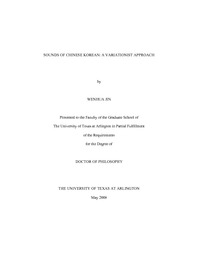
ATTENTION: The works hosted here are being migrated to a new repository that will consolidate resources, improve discoverability, and better show UTA's research impact on the global community. We will update authors as the migration progresses. Please see MavMatrix for more information.
Show simple item record
| dc.contributor.author | Jin, Wenhua | en_US |
| dc.date.accessioned | 2008-08-08T02:31:14Z | |
| dc.date.available | 2008-08-08T02:31:14Z | |
| dc.date.issued | 2008-08-08T02:31:14Z | |
| dc.date.submitted | April 2008 | en_US |
| dc.identifier.other | DISS-2064 | en_US |
| dc.identifier.uri | http://hdl.handle.net/10106/970 | |
| dc.description.abstract | This study approaches the understudied Chinese Korean from a variationist perspective, with an aim to capture the variation patterns and potential changes in the sounds of Chinese Korean. More specifically, three variables were examined: the voice onset time (VOT) of stop consonants and front rounded vowels /y/ and /ø/.
To discern any variation and change in these variables, 35 native speakers of Chinese Korean were interviewed in three different styles and digitally recorded in the Korean community of Shenyang, China. Results of the analysis reveal the existence of a diachronic VOT shift and the "incrementation" of VOT change in the transmission process within this speech community. /ø/ has completely undergone diphthongization into [we],while /y/ presents a more complicated picture with four different variants: [y], [yi], [i] and [u]. It is suggested that instead of undergoing diphthongization as in Seoul Korean, /y/ in Chinese Korean will remain as an underlying monophthong. Variable rule analysis on the four variants of /y/ reveals that [y] occurrence is more favored by word-initial-syllable position; [yi] as a prestigious form is more favored by female and upper class subjects; [i] is basically a sentence reading style indicator; and [u] as a stigmatized form is more common among lower class subjects and in casual style. The [u] variant is also more likely to occur when the preceding segment is [+back].
While the patterns observed above are explicable as reflexes of language-internal variability, one must also consider the possibility of a role played by language and dialect contact. The "transmission" (Labov 2007) within Chinese Korean as a branch of the Korean family tree justifies the continuity of "Chinese Korean" on its own; the "diffusion" across Korean dialects as in the wave model, however, helps foster its similarity, though to varying extent, to its sister. | en_US |
| dc.description.sponsorship | Silva, David J. | en_US |
| dc.language.iso | EN | en_US |
| dc.publisher | Linguistics | en_US |
| dc.title | Sounds Of Chinese Korean: A Variationist Approach | en_US |
| dc.type | Ph.D. | en_US |
| dc.contributor.committeeChair | Silva, David J. | en_US |
| dc.degree.department | Linguistics | en_US |
| dc.degree.discipline | Linguistics | en_US |
| dc.degree.grantor | University of Texas at Arlington | en_US |
| dc.degree.level | doctoral | en_US |
| dc.degree.name | Ph.D. | en_US |
| dc.identifier.externalLink | https://www.uta.edu/ra/real/editprofile.php?onlyview=1&pid=1554 | |
| dc.identifier.externalLinkDescription | Link to Research Profiles | |
Files in this item
- Name:
- umi-uta-2064.pdf
- Size:
- 9.143Mb
- Format:
- PDF
This item appears in the following Collection(s)
Show simple item record


